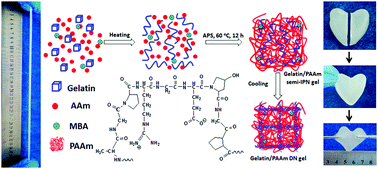High strength and self-healable gelatin/polyacrylamide double network hydrogels†
Abstract
Double network (DN) hydrogels composed of two different polymer networks with strong asymmetry are excellent structural platforms to integrate different mechanical properties into a single material. However, simultaneously achieving high strength and self-healing properties in DN hydrogels still remains a challenge. In this work, we design and synthesize Gelatin/Polyacrylamide (Gelatin/PAAm) DN gels by combining thermo-reversible and physically crosslinked gelatin as the first network and covalently crosslinked PAAm as the second network. The optimized Gelatin/PAAm DN gels demonstrated high mechanical properties (E of 84 kPa, σf of 0.268 MPa, εf of 40.69 mm mm−1 and W of 6.01 MJ m−3), large hysteresis (up to 1012 kJ m−3 at λ = 30), and rapid self-recovery properties (∼87% toughness recovery at room temperature). These superior properties were largely attributed to effective energy dissipation via the rupture of the first gelatin network. Most interestingly, Gelatin/PAAm DN gels without any chemical crosslinkers in the second network enabled the achievement of both high mechanical strength and fast self-healing properties. By modulating the heating temperatures and healing times, the healed Gelatin/PAAm gels could achieve 53% healing efficiency at a physiological temperature range, which greatly expands their uses for biomedical applications. The combination of high strength, self-recovery, and self-healing properties makes Gelatin/PAAm gels promising candidates for further development and use as thermoresponsive biomaterials under physiological conditions.



 Please wait while we load your content...
Please wait while we load your content...